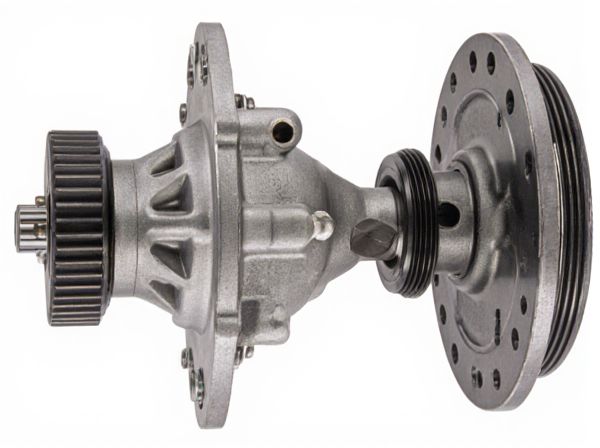
Photo illustration: Electronic Differential vs Mechanical Differential
Electronic differentials enhance vehicle handling by using sensors and software to distribute torque between wheels, improving traction and stability on various surfaces. Mechanical differentials rely on gears to allow wheels to rotate at different speeds, which is essential for smooth cornering but may lead to less efficient power distribution under certain conditions. Your choice depends on the desired balance between advanced control features and traditional mechanical reliability.
Table of Comparison
| Feature | Electronic Differential | Mechanical Differential |
|---|---|---|
| Operation | Uses sensors and actuators to control torque distribution | Uses gears to mechanically split torque between wheels |
| Torque Management | Dynamic and precise torque vectoring for improved handling | Passive torque distribution based on wheel slip |
| Response Time | Instantaneous electronic adjustments | Slower reaction due to mechanical movement |
| Complexity | Higher complexity; requires electronic control units | Lower complexity; purely mechanical components |
| Maintenance | Requires software updates and electronic diagnostics | Requires mechanical servicing and lubrication |
| Cost | Generally more expensive due to advanced components | More affordable and widely used |
| Durability | Dependent on electronic parts lifespan | Robust with proven mechanical reliability |
| Use Case | High-performance, sports, and AWD vehicles | Conventional vehicles and off-road applications |
Introduction to Differentials
Differentials are essential components in vehicles that enable wheels to rotate at different speeds, especially during turns. Mechanical differentials use gears to distribute torque between wheels, allowing smooth cornering but may slip under low traction conditions. Electronic differentials employ sensors and electronic controls to precisely manage torque distribution, enhancing stability and traction in various driving scenarios.
What is a Mechanical Differential?
A mechanical differential is a gear system in vehicles that allows wheels to rotate at different speeds while transmitting engine power, essential for smooth cornering. It typically consists of bevel gears and spider gears that distribute torque between the wheels on the same axle. Unlike an electronic differential, it operates purely on mechanical principles without electronic controls or sensors.
How Electronic Differentials Work
Electronic differentials use sensors and control modules to independently adjust torque distribution between wheels, enhancing vehicle stability and traction. By continuously monitoring wheel speed, steering angle, and throttle input, the system dynamically regulates braking and power delivery to prevent wheel slip. This technology offers superior precision compared to mechanical differentials, improving cornering performance and reducing tire wear.
Key Differences Between Mechanical and Electronic Differentials
Mechanical differentials rely on gears to distribute torque between wheels, allowing for smooth cornering by compensating for wheel speed differences, whereas electronic differentials use sensors and electronic control units to modulate braking and torque delivery for improved traction and stability. Electronic differentials offer faster response times and adaptive control based on real-time driving conditions, enhancing vehicle performance on varied surfaces compared to the fixed mechanical setup. The key distinction lies in mechanical differentials' purely mechanical operation versus electronic differentials' use of software algorithms and sensor feedback for dynamic torque management.
Performance Benefits of Electronic Differentials
Electronic differentials provide superior traction control by independently modulating torque to each wheel, enhancing vehicle stability and cornering precision compared to mechanical differentials. Their precise, real-time adjustments reduce wheel slip and improve handling on varying road conditions, leading to increased safety and performance. This advanced torque vectoring capability also optimizes power distribution, boosting acceleration and efficiency in high-performance and all-wheel-drive vehicles.
Mechanical Differential: Advantages and Limitations
Mechanical differentials provide reliable torque distribution between wheels, enhancing traction on varied road surfaces without electronic intervention. Their robust design ensures durability and minimal maintenance, making them ideal for off-road and heavy-duty vehicles. Limitations include reduced efficiency on slippery surfaces where wheel slip occurs, as they cannot actively control torque distribution like electronic differentials.
Application in Modern Vehicles
Electronic differentials enhance vehicle stability and traction by precisely controlling torque distribution between wheels, making them ideal for modern all-wheel-drive and electric vehicles. Mechanical differentials provide reliable torque division using gears, commonly found in traditional internal combustion engine vehicles where simplicity and durability are prioritized. Advancements in electronic differential technology improve handling in dynamic driving conditions, integrating seamlessly with vehicle stability control and autonomous driving systems.
Maintenance and Longevity Comparison
Electronic differentials require less frequent maintenance than mechanical differentials due to fewer moving parts and reduced wear from friction. Mechanical differentials need regular lubrication checks and gear inspections to prevent wear and failure, impacting their longevity. Electronic differentials generally offer longer service life and improved durability in harsh driving conditions, contributing to lower maintenance costs over time.
Cost and Implementation Factors
Electronic differentials typically incur higher initial costs due to advanced sensors and electronic control units, whereas mechanical differentials are generally more affordable with simpler construction. Implementation of electronic differentials demands complex integration with the vehicle's onboard systems and software calibration, while mechanical differentials rely on established, straightforward mechanical components. Maintenance expenses tend to be lower for mechanical differentials because of their durability and ease of repair compared to the more specialized electronic systems.
Future Trends in Differential Technology
Electronic differentials are poised to dominate future automotive designs due to their superior torque distribution precision and integration with advanced driver-assistance systems. Mechanical differentials, reliant on gears and limited by physical friction, are increasingly being supplemented or replaced by electronic systems that enable faster response times and improved vehicle stability control. Trends indicate a shift toward fully digital, sensor-driven differentials that enhance efficiency and adaptability in electric and autonomous vehicles.
 caratoz.com
caratoz.com